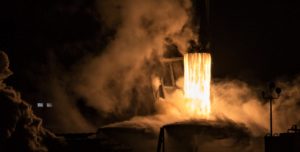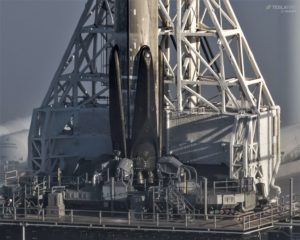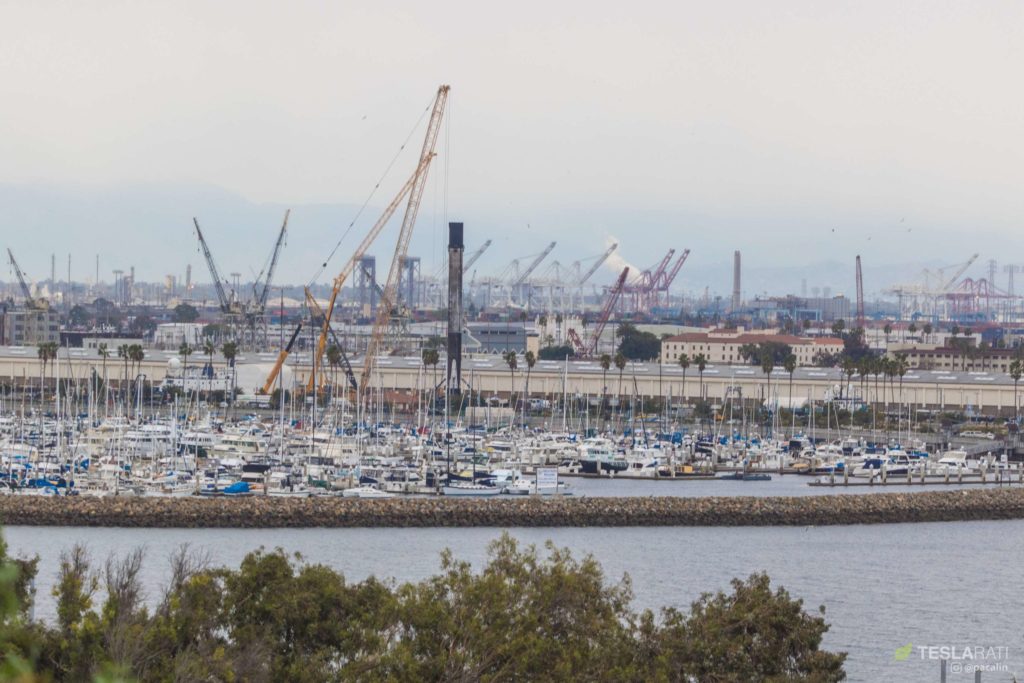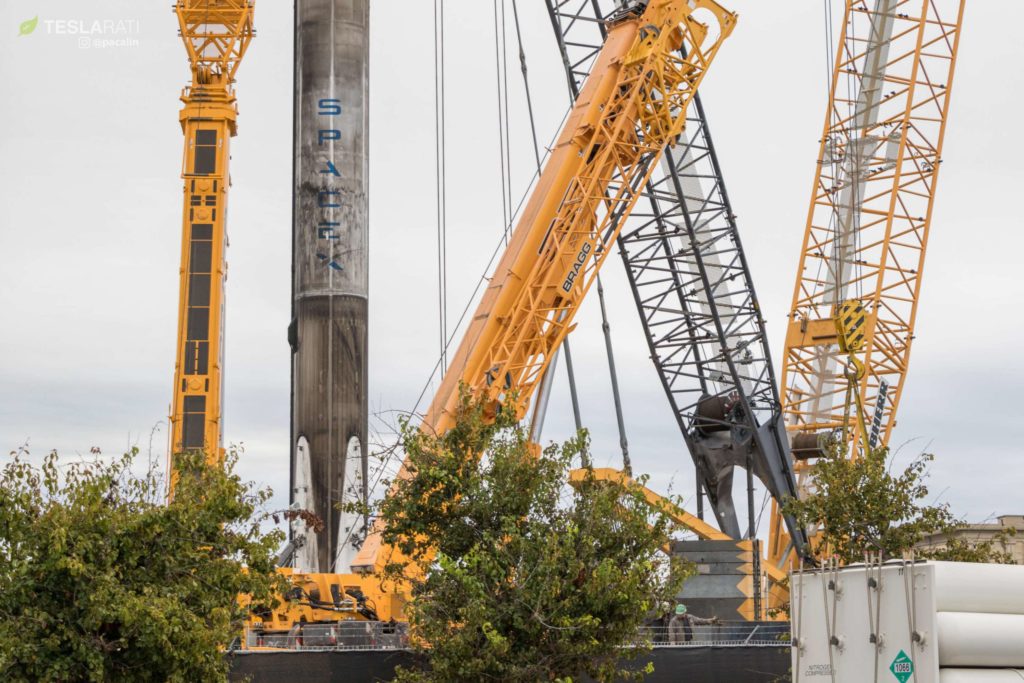
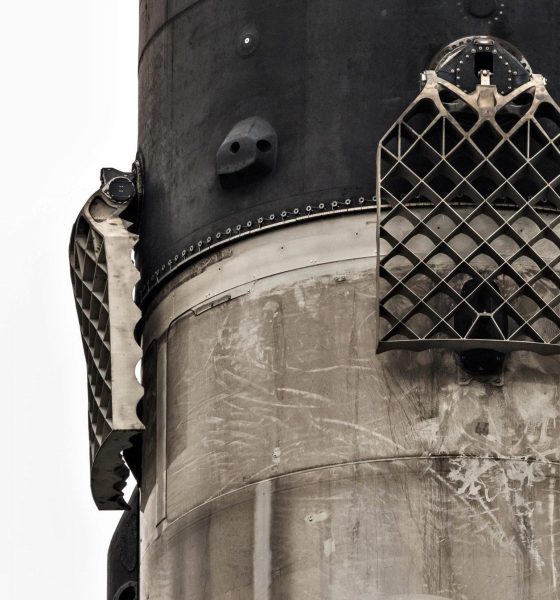
News
SpaceX Falcon 9 booster sails into port after historic third launch and landing
Although a sister rocket did not fare nearly as well during a separate landing attempt 48 hours later, SpaceX Falcon 9 Block 5 booster B1046 nailed its third successful launch and landing on December 3rd and arrived in Port of Los Angeles a bit less than 48 hours later.
Greeting the rocket after its milestone third reuse was a rare Los Angeles rainstorm, lending a lovely reflective sheen to all uncovered surfaces as low clouds and an obscured sun bathed everything in a stark and uniform off-white light.
That’s one scorched booster, still standing on JRTI at the moment, in the rain. B1046.3 arrived back at port earlier this morning after launching and landing for the 3rd time during the SSO-A mission. What. A. Sight. #spacex pic.twitter.com/EhHY9HK9cD
— Pauline Acalin (@w00ki33) December 5, 2018
It is difficult to conceive of a set of conditions that might serve to better emphasize the well-worn patina of soot and charring now fully covering the once-shiny white exterior of B1046’s fuel and oxidizer tanks, a sort of literal badge of honor for the three orbital-class launches the booster has now supported in the last six months. Functionally speaking, cleaning a Falcon 9 booster from top to bottom would be an unbelievably tedious, time-consuming, and largely pointless task, requiring careful spot-cleaning of something like 400 square meters (4300 square feet).

While SpaceX did repaint recovered Falcon 9 boosters a handful of times around the start of commercial reflights, it always served more of an aesthetic purpose over anything seriously utilitarian. Furthermore, aerospace-grade paint like that used by SpaceX is quite heavy potentially weighing several hundred kilograms per booster and requiring a week at minimum to fully apply a new coat. Some followers like to point out the lost benefits of Falcon 9’s reflective white paint, serving as a mild thermal insulator for Falcon 9’s tanks when filled with supercool propellant. While it certainly exists, the additional heating induced by soot coatings is completely negligible for Falcon 9, which is constantly topped off with chilled propellant prior to launch.
As such, sooty boosters will be around as long as the kerolox-power Falcon family remains in operation. Not too long from now, shiny new Falcon rockets will likely be as rare as the expendable rocket launches they partially represent – the launch vehicles of the future will be rugged workhorses more comparable to the 737s that fill the ranks of airliner fleets than to single-use works of art. Nevertheless, soot is by no means an innate feature of rockets, reusable or otherwise, instead deriving from Falcon 9’s pragmatic choice of kerosene as fuel – soot is simply an inevitable byproduct of kerosene combustion.
- Falcon 9 B1049 lifts off for the first time at SpaceX’s LC-40 pad in September 2018. (Teslarati)
- B1048 bares its sooty skin the morning before launch. (Pauline Acalin)
- A gif of Raptor throttling over the course of a 90+ second static-fire test in McGregor, Texas. (SpaceX)
- SpaceX’s subscale Raptor engine has completed more than 1200 seconds of testing in less than two years. (SpaceX)
A long and sooty future
Whenever it begins flying, the sole byproducts of the combustion of BFR/Starlink/Super Heavy’s methane-oxygen (methalox) propellant are water vapor and carbon dioxide, although true methane supplies will inevitably have slight impurities and thus cause the negligible production of some less pleasant byproducts. Raptor, the methalox rocket engine that will power BFR, has been performing hot-fire tests for more than two years, and the sheer differences between the exhaust of Merlin and Raptor are a striking example of the different chemistries at work. As a result of much cleaner combustion, BFR may produce no soot byproducts whatsoever – enjoy it while it lasts!
In the meantime, Falcon 9 will continue to fly and refly for the foreseeable future. B1046’s third successful launch and recovery is a huge step in that direction and the very fact that the most noticeable difference is a new coating of soot at least partially hints at the efficacy of Block 5’s reusability-minded upgrades. Even when twice-flown Block 5 octaweb heat shields are glimpsed, it’s all but impossible to tell the difference between an unflown or twice-flown example, while the new jet-black thermal protection on Block 5 interstages and octawebs only exhibit subtle scarring after reentry heating.
It almost goes without saying that the real killer in multi-use aerospace products – fatigue – is rarely visible to the naked eye, so the external appearance of Falcon boosters is more of a swoon-worthy placebo than anything else. Still, Falcon 9 Block 5 continues to demonstrate that its external appearance is almost equally indicative of truly robust reusability engineering.
- B1046. (Pauline Acalin)
- . . . (Pauline Acalin)
- ENHANCE! (Pauline Acalin)
For prompt updates, on-the-ground perspectives, and unique glimpses of SpaceX’s rocket recovery fleet check out our brand new LaunchPad and LandingZone newsletters!

News
Tesla (TSLA) receives “Buy” rating and $551 PT from Canaccord Genuity
He also maintained a “Buy” rating for TSLA stock over the company’s improving long-term outlook, which is driven by autonomy and robotics.

Canaccord Genuity analyst George Gianarikas raised his Tesla (NASDAQ:TSLA) price target from $482 to $551. He also maintained a “Buy” rating for TSLA stock over the company’s improving long-term outlook, which is driven by autonomy and robotics.
The analyst’s updated note
Gianarikas lowered his 4Q25 delivery estimates but pointed to several positive factors in the Tesla story. He noted that EV adoption in emerging markets is gaining pace, and progress in FSD and the Robotaxi rollout in 2026 represent major upside drivers. Further progress in the Optimus program next year could also add more momentum for the electric vehicle maker.
“Overall, yes, 4Q25 delivery expectations are being revised lower. However, the reset in the US EV market is laying the groundwork for a more durable and attractive long-term demand environment.
“At the same time, EV penetration in emerging markets is accelerating, reinforcing Tesla’s potential multi‑year growth runway beyond the US. Global progress in FSD and the anticipated rollout of a larger robotaxi fleet in 2026 are increasingly important components of the Tesla equity story and could provide sentiment tailwinds,” the analyst wrote.
Tesla’s busy 2026
The upcoming year would be a busy one for Tesla, considering the company’s plans and targets. The autonomous two-seat Cybercab has been confirmed to start production sometime in Q2 2026, as per Elon Musk during the 2025 Annual Shareholder Meeting.
Apart from this, Tesla is also expected to unveil the next-generation Roadster on April 1, 2026. Tesla is also expected to start high-volume production of the Tesla Semi in Nevada next year.
Apart from vehicle launches, Tesla has expressed its intentions to significantly ramp the rollout of FSD to several regions worldwide, such as Europe. Plans are also underway to launch more Robotaxi networks in several more key areas across the United States.
News
Waymo sues Santa Monica over order to halt overnight charging sessions
In its complaint, Waymo argued that its self-driving cars’ operations do not constitute a public nuisance, and compliance with the city’s order would cause the company irreparable harm.

Waymo has filed a lawsuit against the City of Santa Monica in Los Angeles County Superior Court, seeking to block an order that requires the company to cease overnight charging at two facilities.
In its complaint, Waymo argued that its self-driving cars’ operations do not constitute a public nuisance, and compliance with the city’s order would cause the company irreparable harm.
Nuisance claims
As noted in a report from the Los Angeles Times, Waymo’s two charging sites at Euclid Street and Broadway have operated for about a year, supporting the company’s growing fleet with round-the-clock activity. Unfortunately, this has also resulted in residents in the area reportedly being unable to sleep due to incessant beeping from self-driving taxis that are moving in and out of the charging stations around the clock.
Frustrated residents have protested against the Waymos by blocking the vehicles’ paths, placing cones, and “stacking” cars to create backups. This has also resulted in multiple calls to the police.
Last month, the city issued an order to Waymo and its charging partner, Voltera, to cease overnight operations at the charging locations, stating that the self-driving vehicles’ activities at night were a public nuisance. A December 15 meeting yielded no agreement on mitigations like software rerouting. Waymo proposed changes, but the city reportedly insisted that nothing would satisfy the irate residents.
“We are disappointed that the City has chosen an adversarial path over a collaborative one. The City’s position has been to insist that no actions taken or proposed by Waymo would satisfy the complaining neighbors and therefore must be deemed insufficient,” a Waymo spokesperson stated.
Waymo pushes back
In its legal complaint, Waymo stated that its “activities at the Broadway Facilities do not constitute a public nuisance.” The company also noted that it “faces imminent and irreparable harm to its operations, employees, and customers” from the city’s order. The suit also stated that the city was fully aware that the Voltera charging sites would be operating around the clock to support Waymo’s self-driving taxis.
The company highlighted over one million trips in Santa Monica since launch, with more than 50,000 rides starting or ending there in November alone. Waymo also criticized the city for adopting a contentious strategy against businesses.
“The City of Santa Monica’s recent actions are inconsistent with its stated goal of attracting investment. At a time when the City faces a serious fiscal crisis, officials are choosing to obstruct properly permitted investment rather than fostering a ‘ready for business’ environment,” Waymo stated.
News
Tesla FSD v14.2.2 is getting rave reviews from drivers
So far, early testers have reported buttery-smooth drives with confident performance, even at night or on twisty roads.

Tesla Full Self-Driving (Supervised) v14.2.2 is receiving positive reviews from owners, with several drivers praising the build’s lack of hesitation during lane changes and its smoother decision-making, among others.
The update, which started rolling out on Monday, also adds features like dynamic arrival pin adjustment. So far, early testers have reported buttery-smooth drives with confident performance, even at night or on twisty roads.
Owners highlight major improvements
Longtime Tesla owner and FSD user @BLKMDL3 shared a detailed 10-hour impression of FSD v14.2.2, noting that the system exhibited “zero lane change hesitation” and “extremely refined” lane choices. He praised Mad Max mode’s performance, stellar parking in locations including ticket dispensers, and impressive canyon runs even in dark conditions.
Fellow FSD user Dan Burkland reported an hour of FSD v14.2.2’s nighttime driving with “zero hesitations” and “buttery smooth” confidence reminiscent of Robotaxi rides in areas such as Austin, Texas. Veteran FSD user Whole Mars Catalog also demonstrated voice navigation via Grok, while Tesla owner Devin Olsen completed a nearly two-hour drive with FSD v14.2.2 in heavy traffic and rain with strong performance.
Closer to unsupervised
FSD has been receiving rave reviews, even from Tesla’s competitors. Xpeng CEO He Xiaopeng, for one, offered fresh praise for FSD v14.2 after visiting Silicon Valley. Following extended test drives of Tesla vehicles running the latest FSD software, He stated that the system has made major strides, reinforcing his view that Tesla’s approach to autonomy is indeed the proper path towards autonomy.
According to He, Tesla’s FSD has evolved from a smooth Level 2 advanced driver assistance system into what he described as a “near-Level 4” experience in terms of capabilities. While acknowledging that areas of improvement are still present, the Xpeng CEO stated that FSD’s current iteration significantly surpasses last year’s capabilities. He also reiterated his belief that Tesla’s strategy of using the same autonomous software and hardware architecture across private vehicles and robotaxis is the right long-term approach, as it would allow users to bypass intermediate autonomy stages and move closer to Level 4 functionality.
